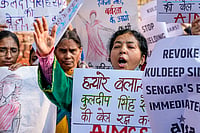Get ready for yet another hike in petrol and diesel prices. This time, the increase may be steeper. Petroleum minister Mani Shankar Aiyar has been advocating it for a while now. But the UPA government succumbed to the pressures from the Left and resisted any drastic decision that may affect the common man. Finally, it seems the government will just have to choose carefully between economics and politics.
Global crude prices have moved northwards. Indian oil (refining and marketing) PSUs, which import the bulk of their requirements, have seen dramatic cost increase. Unable to pass on the burden to consumers, they've seen their bottomlines slide. In fact, a number of oil PSUs have reported net losses for the first time in their operational history in the first quarter (April-June) this year (see tables).
The combined losses of all the oil companies last quarter was nearly Rs 1,500 crore. Contrast this with the fact that IOC (Indian Oil Corporation) itself earned a net profit of over Rs 1,472 crore in the same quarter (April-June) in 2004. Aiyar contends that under-recoveries—due to oil firms' inability to increase retail prices—in the first quarter of 2005-06 was nearly Rs 10,000 crore, which will exceed Rs 40,000 crore for the entire year.
If true, it's a worrisome situation for the government. At one level, it implies that some of the so-called profitable navaratna PSUs may soon turn into non-performers. And, at another one, it will impact the exchequer—oil PSUs contributed Rs 4,000 crore as dividends in 2004-05. They'll be unable to do that this year. The result: the fiscal deficit will go up, a situation finance minister P. Chidambaram will hate to be in.
Oil PSUs blame the government for their losses. Explains Ashok Sinha, CMD, BPCL (Bharat Petroleum Corporation Ltd): "The losses are directly reflective of the increasing global (crude) prices and our inability to recover that from the customers. Unless something drastic is done now, the situation may go beyond our control." True, for spot crude prices have crossed the $60 per barrel mark. The US light has risen by 40 per cent this year.
S.V. Narasimhan, IOC's new director, finance, has already predicted a second quarter loss if prices are not increased immediately. Agrees BPCL's Sinha: "The price increase in June was wiped out by the current rise in crude prices. As a result, the under-recoveries in July for the four main products—motor spirit, high-speed diesel, kerosene and lpg—have risen so much that the losses could be far more in the second quarter."
Look at it from a different perspective. Last year, the country imported crude at an average price of $39 per barrel as it sourced its requirements from various sources, some that sold below the prevailing international spot prices. But the figure rose to $51 this April and is close to $60 today. In comparison, petrol and diesel prices have risen by a mere Rs 4.78 and Rs 5.71 per litre respectively in the past 12 months. In actual terms, the hikes should have been Rs 4.68 for petrol and Rs 5.13 for diesel this June while the actual hike was of Rs 2.50 and Rs 2 per litre only. Kerosene prices haven't changed since April 2002. The oil PSUs are losing Rs 92 per lpg cylinder and Rs 11 per litre on kerosene. They are reimbursed only a third of the subsidy on these two fuels.
Until recently, the oil PSUs were able to report profits because of their burgeoning refining margins, despite the losses on the marketing front due to low retail prices of petroproducts. However, refining margins too have come down. IOC's gross margins in this area fell from $6.87 per barrel to $6.16 in the past one year. Admits BPCL's Sinha: "The refinery business is no longer in a position to subsidise our marketing losses."
The government's earlier stop-gap arrangement was to ask profit-making oil and gas PSUs like ONGC, oil and GAIL to share the subsidy burden of the refining and marketing firms. But it didn't pay off as the amounts were not enough to offset the increase in global crude prices. The upstream firms made a huge contribution of Rs 3,257 crore to the latter.
Some analysts, however, don't agree. They believe that the oil PSUs are probably showing losses in a bid to force the government to hike retail prices. One gets a few hints by analysing IOC's first quarter results this year. In quantitative terms, IOC's sales have gone down. Its refinery throughput was down from 10.34 million tonnes in the first quarter of 2004-05 to 9.18 million tonnes this year. Its pipeline throughput too fell from 11.96 to 11.13 million tonnes in the same period. This may be the real reason that explains IOC's minor loss in the first quarter this fiscal.
Whatever might be the reason for the PSU losses, the IOC management feels that the losses will impair the company's long-term plans of becoming a $60 billion entity by 2011. IOC managers claim that it's incurring a revenue loss of Rs 1,800 crore a month at current global oil prices and domestic retail prices. Says IOC's CMD Sarthak Behuria: "We have ambitious plans lined up, including acquisitions abroad. For this, we need to generate internal surpluses. If under-recoveries continue, we will be forced to take a relook at the projects." Already, it seems that IOC's proposed refinery at Paradip (Orissa) may be delayed or even put on the backburner. Behuria contends the Q 1 loss will force IOC to review its plans to invest Rs 6,000-7,000 crore a year on new projects.
To save the day for the oil PSUs, Aiyar has made his strongest pitch ever, in Parliament: "The new and very disturbing trend is that our navaratna and mini-ratna oil marketing companies are beginning to suffer net or cash losses, seriously incapacitating their abilities to meet capital expenditure targets or maintain dividends on equity. What is perhaps even more worrying is that in July, after we revised the (retail) prices, these companies, or some of them, still appear to be making losses, and are having difficulties meeting their investment targets."
Still, Aiyar is apprehensive of the government's decision to increase retail prices. He admitted in the same speech that the government will have to weigh political considerations before allowing higher prices because it had to balance the interests of various stakeholders—consumers, government and the oil companies. He added: "The question of pricing is a politico-economic one that involves the cabinet." The primary fear is that any hikes may fuel inflation, apart from affecting the coalition partners' votebanks. Will economics triumph over politics?
More Rs Per Litre
Despite the soaring international market, UPA deferred substantial hike in oil prices. Pay-up time draws nigh.

More Rs Per Litre
More Rs Per Litre
Published At:
MOST POPULAR
WATCH
MORE FROM THE AUTHOR
×

















